
Polypores are a group of fungi that form large fruiting bodies with pores or tubes on the underside. They are a morphological group of basidiomycetes-like gilled mushrooms and hydnoid fungi, and not all polypores are closely related to each other. Polypores are also called bracket fungi or shelf fungi, and they characteristically produce woody, shelf- or bracket-shaped or occasionally circular fruiting bodies that are called conks.
Abundisporus quercicola is a species of bracket fungus that grows on living oaks in temperate forests in the foothills of the Himalaya. The fruit bodies are perennial, grey to black above with concentric markings and white below. The fungus grows to 7 cm wide and 5 cm thick, projecting up to 5 cm from the substrate. The basidiospores are yellow.
Gelatoporia is a fungal genus in the family Gelatoporiaceae. This is a monotypic genus, containing the single widely distributed species Gelatoporia subvermispora. The genus was circumscribed in 1985 by Finnish mycologist Tuomo Niemelä to contain poroid crust fungi with a monomitic hyphal structure, clamped hyphae, and producing white rot.

Skeletocutis is a genus of about 40 species of poroid fungi in the family Polyporaceae. The genus has a cosmopolitan distribution, although most species are found in the Northern Hemisphere. It causes a white rot in a diverse array of woody substrates, and the fruit bodies grow as a crust on the surface of the decaying wood. Sometimes the edges of the crust are turned outward to form rudimentary bracket-like caps.
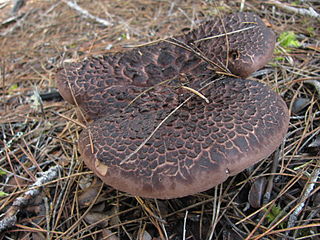
Sarcodon squamosus is a species of basidiomycete fungus in the genus Sarcodon.
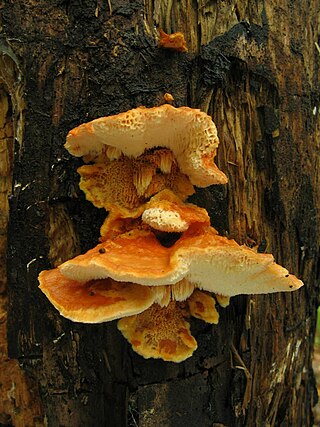
In Finland, Kotiranta and Niemelä introduced a widely used method for comparing the conservation values of different forest areas, based on the observation that certain wood-rotting fungi are very sensitive to the impact of human activities on forest ecosystems. Such species are slow to return to areas from where they have disappeared, so their presence is evidence of a long continuity in forest ecosystems.

Skeletocutis amorpha is a species of poroid fungus in the family Polyporaceae, and the type species of the genus Skeletocutis.
Skeletocutis borealis is a rare species of poroid fungus in the family Polyporaceae. Found in northern Europe, it was described as new to science in 1998 by Finnish mycologist Tuomo Niemelä.
Skeletocutis brevispora is a species of poroid crust fungus in the family Polyporaceae. It was described as new to science in 1998 by Finnish mycologist Tuomo Niemelä.
Skeletocutis brunneomarginata is a species of poroid crust fungus in the family Polyporaceae. Found in the United States, it was described as new to science in 2007 by Norwegian mycologist Leif Ryvarden. He collected the type in Bent Creek Experimental Forest, North Carolina in 2004. The fungus is very similar in appearance to Skeletocutis kühneri, but with a brown margin and subiculum. S. brunneomarginata is one of 14 Skeletocutis species that occurs in North America.
Skeletocutis biguttulata is a species of poroid fungus in the family Polyporaceae. It was first described scientifically by Swedish mycologist Lars Romell in 1932. Tuomo Niemelä redescribed and illustrated the fungus in 1998, and explained that collections of this fungus had previously been attributed to the related Skeletocutis subincarnata. S. biguttulata may be distinguished from the latter fungus by its biguttulate spores, more regularly arranged pores, and the cracking pore surface seen in older specimens.
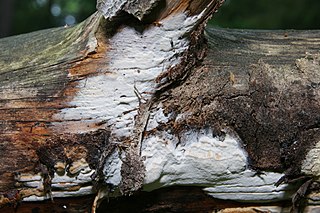
Antrodia pulvinascens is a species of crust fungus in the genus Antrodia that is found in Europe. Czech mycologist Albert Pilát originally described the fungus in 1953 as a species of Poria.
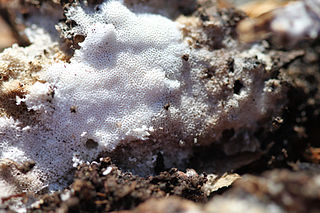
The Gelatoporiaceae are a small family of crust fungi in the order Polyporales. The family was circumscribed in 2017 by mycologists Otto Miettinen, Alfredo Justo and David Hibbett to contain the type genus Gelatoporia and three other related genera, Cinereomyces, Obba, and Sebipora.
Antella niemelaei is a species of poroid crust fungus in the family Steccherinaceae.
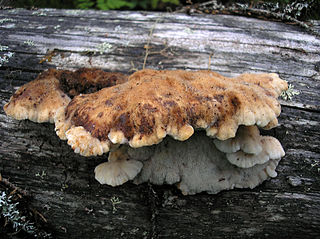
Amylocystis lapponica is a species of bracket fungus in the family Fomitopsidaceae, and the type species of genus Amylocystis. It produces medium-sized, annual fruit bodies that are soft, and have a strong, distinct smell. The fungus is a saprophyte that feeds on coniferous wood of logs lying on the ground, and causes brown rot. It is a rather rare species that only occurs in old-growth forest.
Perenniporia meridionalis is a poroid crust fungus in the family Polyporaceae. It was described as a new species by Cony Decock and Joost Stalpers in 2006. The holotype specimen was collected in the Province of Nuoro in Italy, where it was found growing on dead wood of Quercus ilex. Distinguishing characteristics of this fungus include its relatively large pores, the hyaline vegetative hyphae that are yellowish to slightly dextrinoid in Melzer's reagent, and large spores measuring 6.0–7.7 by 4.5–6.2 µm. P. meridionalis occurs in central and southern Europe, where it is found in warmer forested areas, usually on dead oak wood. It has also been reported to occur in North America.
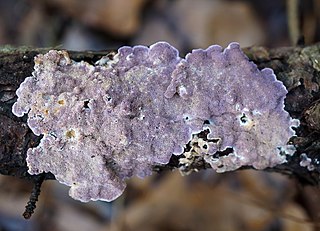
Skeletocutis lilacina is a species of poroid fungus in the family Polyporaceae. Originally found in Switzerland, it was described as a new species in 1984 by mycologists Alix David and Jean Keller. It has also been reported from North America.
Skeletocutis nothofagi is a rare species of poroid crust fungus in the family Polyporaceae that is found in South America. It has been proposed for inclusion in the IUCN Red List of Threatened Species due to its highly restricted distribution and rare occurrence.
Skeletocutis friata is a rare species of poroid crust fungus in the family Polyporaceae. Found in Finland, it was first described as a new species in 1998 by Tuomo Niemelä and Reima Saarenoksa, with the name Skeletocutis friabilis. It was given the epithet friata three years later, after it was discovered that a tropical Asian species had already been given the name Skeletocutis friabilis, with a publication date two months prior to theirs. The holotype was collected by Saarenoksa in Sipoo, southern Finland, where it was found growing on the bark and exposed wood of a fallen twig of common alder. The authors later noted that subsequent searching of the type locality, as well as other locations in southern Finland, failed to turn up additional examples of this species.

Skeletocutis stellae is a species of fungus belonging to the family Polyporaceae.










